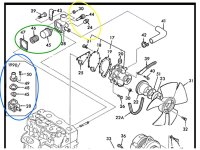JC-jetro
Elite Member
Paul,
You need to follow Jim's direction and report your findings. Below is the reading on my temp sending unit. Beware that they might not all have the same resistance range but it is more than close for diagnostic purposes. Below is copy of what I said on post#12 of this thread.
good luck
JC,
For the sake of compassion only, The sender on my tractor reports 690 ohm cold, 140 ohms @ T-housing temp of 172 and 92 ohms 1/8" on the right side of the middle @ 196 degrees Fahrenheit.
You need to follow Jim's direction and report your findings. Below is the reading on my temp sending unit. Beware that they might not all have the same resistance range but it is more than close for diagnostic purposes. Below is copy of what I said on post#12 of this thread.
good luck
JC,
For the sake of compassion only, The sender on my tractor reports 690 ohm cold, 140 ohms @ T-housing temp of 172 and 92 ohms 1/8" on the right side of the middle @ 196 degrees Fahrenheit.
